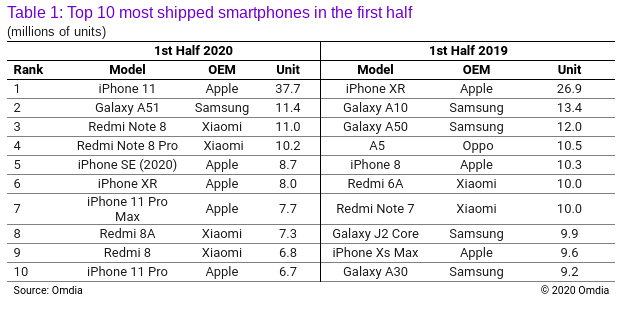In the face of an army of powerful Android phones for all kinds of budgets, Apple’s iPhone 11 dominated the first half of 2020 to become the world’s most-shipped and top selling smartphone. In fact, the iPhone 11 outsold its closest competitor — Samsung’s new Galaxy A51 — by 26 million units.
Even with the pandemic raging, Apple shipped 37.7 million iPhone 11’s in the first half of 2020, compared to just 11.4 million of the Galaxy A51, according to Omdia’s Smartphone Model Market Tracker.

Like Apple’s iPhone XR last year, the cheapest of the 2019 iPhones ranked first in global shipments this year. Despite the impact of Covid-19 in the first half of this year and the movement restrictions imposed in various countries along with it, and production disruptions, iPhone 11 shipped 10.8 million more units than last year’s No. 1, iPhone XR.
A key driver for the success of iPhone 11 is the lower starting price, notes Omdia. iPhone 11 launched $50 cheaper than the previous iPhone XR while adding significant hardware improvements, like a dual-lens camera. iPhone XR did not feature such upgrades.
Apples dominates 2020 top selling smartphone list
Apple’s successful April 2020 addition of its iPhone SE (2020) helped the company position four models in the global top 10 list. As Apple’s new budget iPhone, the iPhone SE shipped 8.7 million units in the second quarter, reaching 5th place in first half shipment volume.
Thanks to the success of the new iPhone SE and last fall’s iPhone 11, Apple shipped 13% more iPhones in the second quarter of 2020 compared to the previous year. Not surprisingly, iPhone SE sales have been helped by growing consumer anxiety over the economic downturn due to Covid-19, and consumer demand for a small-sized iPhone.
By contrast Apple’s premium iPhone 11 Pro Max and Pro ranked 7th and 10th on the list, respectively. Shipments of these two models decreased compared to the previous iPhone Xs Max and Xs, but their rankings improved, according to Omdia.
Samsung swansong?
On the other hand, only one Samsung model made the top 10 this year. Like last year, a mid-end Samsung smartphone, the Galaxy A51, took the second place with a total of 11.4 million units shipped.
This is a big letdown for Samsung, as this list featured four Samsung’s entry-level and mid-range phones last year. So far this year, no Samsung flagship device has reached the top 10.
Who replaced Samsung this time around? That would be China’s Xiaomi — a company now well-known for making cheaper near-clones of rival phones. In the first half of 2020, not one or two but four Xiaomi phones nabbed spots on the top sellers list. All four are Xiaomi’s budget Redmi phones: the Redmi Note 8 ($132) and Note 8 Pro ($162) models took 3rd and 4th place, respectively; and Xiaomi’s Redmi 8A ($85) and Redmi 8 ($97), ranked 8th and 9th on the list.
The popularity of Xiaomi’s Redmi phones is thanks to a general leveling up in performance of lower priced smartphone models, plus an increased consumer preference for budget phones due to the economic recession.
Xiaomi’s fellow Chinese competitor Huawei failed to make Omdia’s top 10 list with any of its devices for the first half of this year. Huawei’s smartphone business is under increasing pressure from US sanctions, impacting the company’s overseas business.
Other phone makers not making Omdia’s H1 2020 top selling smartphone list here include Oppo and Vivo. Though in the second quarter, Oppo, Vivo and Huawei all saw better sales — at least in China, according to another Omdia report.
Based in London, Omdia was established following the merger of Informa Tech’s research division and the acquired IHS Markit technology research portfolio. The company covers 150 markets and publishes over 3,000 research reports annually, reaching over 14,000 subscribers. You can access those reports at Omdia.com’s mobile devices research page.





